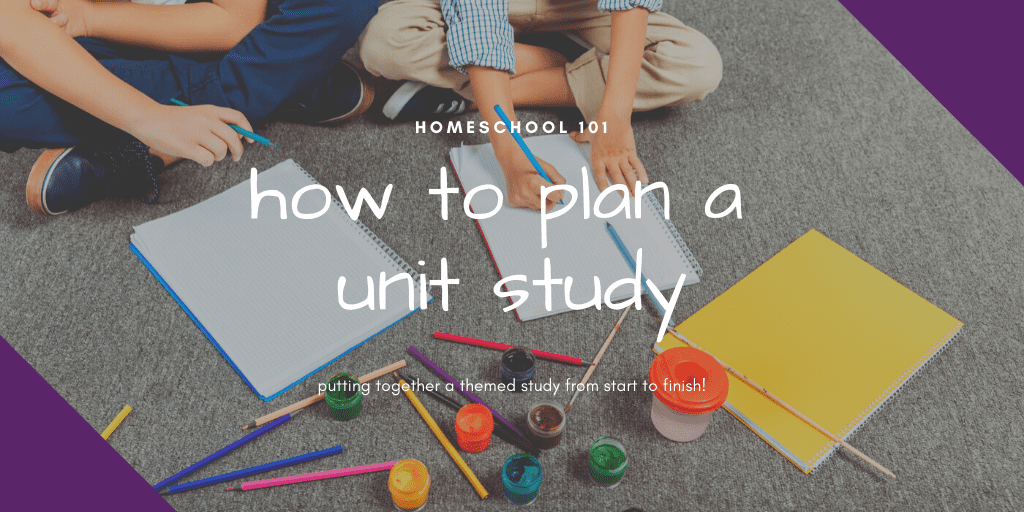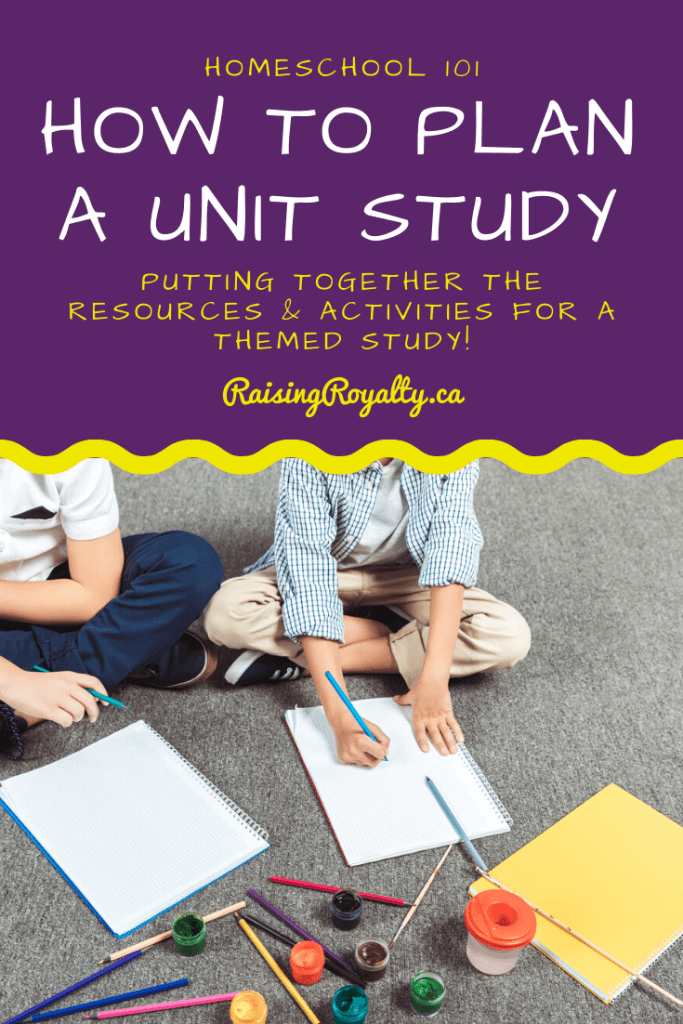

Do you remember having themes when you were in school? It was fun to have spelling words and story time be about the same topic that your science lessons were also covering. Themed studies, also known as unit studies, are fun and easy ways to engage your kids in learning, and cover all the main subjects. Knowing how to plan a unit study will make your homeschool planning easy.
So how do you plan out your unit study?
The biggest part of planning a unit study is figuring out what, exactly, you want to study. It might be easy to say “I want to do a unit on castles!” but what exactly do you want to learn about castles? Choosing your learning points will make planning your unit study much easier.
First, choose your topic.
There are tons of topics out there to choose from. Do you want to help your children make science discoveries? Explore a particular culture and geography? Or maybe delve into the why’s and how’s of an event in history?
Generally, unit studies do a lot better with a science, history or geography-based topic than a language arts or math based topic. Though a geometry or grammar-based unit study might be fun too!


Decide the learning points — what’s the focus?
Once you’ve chosen your topic, take some time to think through what you want your kids to know about this topic.
For example, on a science-based topic, which facts, theories or laws do you want to focus on. If it’s a history-based or geography-based topic, look at the who, what, where, when, why and how of the topic.
Sometimes it’s easier to jot down the questions you want your kids to be able to answer about a topic. Those answers will be your learning points.
What “subjects” will you cover?
Now that you’ve decided on the learning points of your study, match them up to the major subjects. This will help you in determining which activities you want to use to cover those learning points.
If you do your entire study with reading and writing activities, then you’ll only cover language arts. That’s fine, if that’s the only subject you want to cover. But if you want a fully comprehensive unit study, with a wide variety of topics, making sure you cover all the subjects will help with choosing which activities you’ll do.
Determine the end result
What happens when you get to the end of the unit? Figuring out your end result gives you the goal of the study. If you’re struggling to set a goal, it might help to think about what “proves” the learning your kids did. How would you assess what they’ve learned at the end — without a test or quiz?
The proof of learning could be a portfolio, a model, a scrapbook, or maybe a public demonstration or display. Maybe you’ll have your child build a comprehensive diorama of the ocean while studying marine animals. Or maybe putting together a “tourist guidebook” while studying the country of Brazil? Try preparing and enjoying a medieval banquet after learning about knights and castles, complete with costumes!
The end result of your unit study can make the learning memorable and help your kids get excited about the topic.


Find your resources
After you’ve decided on the “what” of your unit study, it’s time to determine the “how” of the study. Which resources and activities will you use to bring home your learning points?
Books
There are three types of books you can use in a unit study.
First, there are the general non-fiction type books. Think DK Eyewitness or Usborne Encyclopedias. These cover multiple subtopics within the bigger topic, all in one book.
Second, there are more story-like, topic-specific non-fiction books. For example, the “You Wouldn’t Want to Be… ” or “If you were a …” series are great examples. They are engaging and entertaining, without giving information overload.
Last, there are fiction books on your topic. A good read-aloud book can bring your topic to life for your kids. And some great picture books on the topic, or short stories capture their attention. Sometimes, a good fiction book can be the hook for your topic, and you extend the learning based on the book.
Kits
Using topical kits can be an easy way to create learning activities. And they are both easy to find and affordable to get. From lapbook kits to science demonstration kits, there are tons of options out there. Check out your local educational toy store for lots of great choices.
Some of our favorites include lapbooks from Hands of a Child, and Magic School Bus science kits. We also like to use model kits (ie. a Solar System model or a dinosaur model) to help illustrate the key learning points of our unit studies.
Online
With games, interesting kid-friendly informational sites, web quests and interactive quizzes, there are so many online resources to enhance your unit study.
I’ve found a lot of really good online resources on the websites of print magazines or public institutions. Want a virtual field trip? Check out a famous museum’s website. You could dissect a virtual frog, put together a human skeleton online, or solve a murder mystery.
Some of my favorite online information sites are:


Video/Audio
Sometimes there’s nothing better than a good documentary to capture your kids’ imagination. YouTube is great source for quality documentaries, but be careful of the channels you source them from. We like NASA, National Geographic and BBC Timeline for longer documentaries. We also like Crash Course and Sci Show for shorter snippets. Both those channels offer kids’ versions as well as videos for adults, but we use both!
Podcasts and audiobooks can also be a great resource for your unit study. My kids love listening to Dan Carlin’s history podcast on long trips, or while they’re playing quiet games inside. Brains on Science is a fun science-based podcast, and so is Tumble.
You could also try fun geography-, history- or science-based shows, like Expedition Unknown and Wild Kratts.
Field Trips
If you really want to explore a topic, there’s nothing better than getting up close and personal. So a field trip or two can be the perfect start or finish to your unit study.
Spark your child’s curiosity with a trip to a re-enactment of a famous battle or event related to your topic. Or visit a village set in the past to explore that time period. A natural history museum or aquarium might be the perfect finish to your study on animals, or explore a botanical gardens or national park to finish a study on plants.
Classes / Extracurriculars
If your unit study is going to be a longer themed study, you may want to consider enrolling your child in a class or extracurricular group. These can be nice additions to your explorations at home.
For example, if you’re doing a unit study on space, your family could join a junior astronomy club or stargazing group. Or if you’re studying the Renaissance period, maybe a painting class with the local art gallery would be a fun extension.
Unit studies are about getting creative in your learning.
Gather Supplies
After you’ve figured out and obtained the resources you need for your unit study, it’s time to gather together all the supplies. You’ll need, (obviously) your school supplies like paper, pencils, erasers, scissors, etc. And depending on the projects you’ll be doing as part of your unit study, you’ll need art supplies. You may also want to get some toys or demonstrative equipment to have on hand. And double-check that the technology you have can do the tasks you want them to do.
School supplies
First, inventory and top up your school supplies. Pencils, erasers, markers, pens, paper and stickers are helpful to keep around. You may also want brads, cardstock, glue and scissors for scrapbooking or lapbooking.
Art supplies
Think about the projects you’ve planned and gather the supplies you need for all of them. You could wait till you get to that part of the study, if you like, but I’ve found I’m more likely to skip a project when I don’t have the supplies on had right away. So for me, it’s always better to get everything I need right away.
Commonly used supplies could be
- paint and paintbrushes,
- modeling clay and tools,
- ribbon, tissue paper, pipe cleaners and yarn,
- buttons, pom poms, googly eyes and decorative bits and bobs,
- paper bags, foam balls, fabric scraps and paper plates
Demonstration / toys / manipulatives
We love to get hands-on with unit studies, so having lots of things we can repurpose is important.
For example, Lego sets or building blocks can be used to build re-enactment models. Dress up clothes can help with role-playing historical events. Demonstrate physics experiments with toy cars and ramps, or use stuffed animals to simulate the effects of gravity.
Technology
This seems obvious, since just to access this post you have to access to the internet. But not all devices are the same. Double check that your children can get onto the online game or demonstration you want them to use online before you plan to use it. And watch the video or listen to the podcast before letting your children hear and watch it, to screen for inappropriate content.
Plan your calendar
Once you have your resources and supplies, it’s time to put it all together.
Use a monthly calendar to plot out your “big” events, such as when you’ll go on that field trip or build that model castle. You don’t want to plan on going to the aquarium on the Thursday before your son’s birthday party, because you may want that time to get ready for the party. And you may not want to have a messy volcano science experiment in your kitchen the same day that you’re hosting the neighbours over for dinner.
Use a planning page to list out the activities and projects in the order you want to do them. Then estimate how long it will take you to finish them. Some things might be just 30 minutes, but some things might stretch over 2-3 days.
Finally, put together the daily plan for your activities. Which learning point are you talking about that day? What books will you use? Which chapters or page numbers will you be reading? Which activities will you do? Is there a game, video, audio or demonstration you want your child to complete? Put all that down on your daily plan.
Implement
Now comes the fun part! It’s time to take all that planning, all those resources and all those supplies and put them to use. Start with your first day’s plan, and keep going!
It’s ok when things don’t go to plan. Stay flexible, and adjust your plans accordingly. Maybe some books just don’t interest your kids the way you thought? Drop them. You discovered they really really like getting messy? Spend more time repeating the messier experiments.
Don’t forget to take pictures of your studies!
Celebrate
When you’ve completed your final project, and you’ve done all the things, read all the books, gone to all the places and watched all the videos, it’s time to celebrate! Take a well-deserved break. Treat the kids to ice cream or time at the playground. Look back over the pictures you took and congratulate yourself on a job well done.


